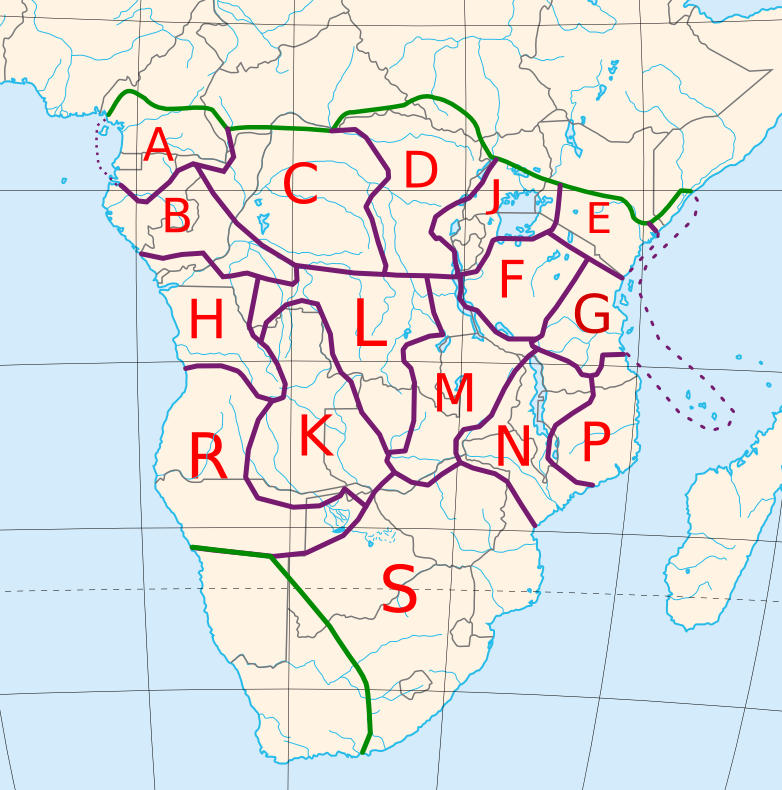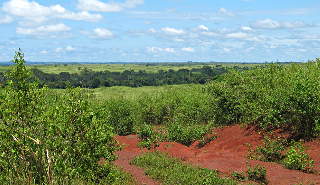|
Kol Language (Cameroon And Gabon)
Kol is a Niger–Congo language of the Bantu family, associated with the Bikélé ethnic group. It is spoken in the East Province of Cameroon, in the vicinity of Messaména. Alternate names for Kol language include Bikele-Bikay, Bikele-Bikeng, Bikélé, and Bekol. Demographics Kol, also known as Bekol or Bikele, is located in the northern part of Messamena, Haut-Nyong Haut-Nyong is a department of East Province in Cameroon. The department covers an area of 36,384 km and as of 2001 had a total population of 216,768. The capital of the department lies at Abong-Mbang. Subdivisions The department is divide ... Department (Eastern Region), south of Meka. It is closely related to Meka and has 12,000 speakers (''Ethnologue'' 2000). References Further reading * Henson, Bonnie Jean. 2007. The phonology and morphosyntax of Kol. Ph.D., University of California, Berkeley. xx, 592 p. Languages of Cameroon Makaa-Njem languages {{Bantu-lang-stub ... [...More Info...] [...Related Items...] OR: [Wikipedia] [Google] [Baidu] |
Cameroon
Cameroon (; french: Cameroun, ff, Kamerun), officially the Republic of Cameroon (french: République du Cameroun, links=no), is a country in west- central Africa. It is bordered by Nigeria to the west and north; Chad to the northeast; the Central African Republic to the east; and Equatorial Guinea, Gabon and the Republic of the Congo to the south. Its coastline lies on the Bight of Biafra, part of the Gulf of Guinea and the Atlantic Ocean. Due to its strategic position at the crossroads between West Africa and Central Africa, it has been categorized as being in both camps. Its nearly 27 million people speak 250 native languages. Early inhabitants of the territory included the Sao civilisation around Lake Chad, and the Baka hunter-gatherers in the southeastern rainforest. Portuguese explorers reached the coast in the 15th century and named the area ''Rio dos Camarões'' (''Shrimp River''), which became ''Cameroon'' in English. Fulani soldiers founded the Adamawa E ... [...More Info...] [...Related Items...] OR: [Wikipedia] [Google] [Baidu] |
Atlantic–Congo Languages
The Atlantic–Congo languages are the largest demonstrated family of languages in Africa. They have characteristic noun class systems and form the core of the Niger–Congo family hypothesis. They comprise all of Niger–Congo apart from Mande, Dogon, Ijoid, Siamou, Kru, the Katla and Rashad languages (previously classified as Kordofanian), and perhaps some or all of the Ubangian languages. Mukarovsky's West-Nigritic corresponded roughly to modern Atlantic–Congo. In the infobox, the languages which appear to be the most divergent are placed at the top.Roger BlenchNiger-Congo: an alternative view/ref> The Atlantic branch is defined in the narrow sense, while the former Atlantic branches Mel and the isolates Sua, Gola and Limba, are split out as primary branches; they are mentioned next to each other because there is no published evidence to move them; Volta–Congo is intact apart from Senufo and Kru. In addition, Güldemann (2018) lists Nalu Nalu may refer to: ... [...More Info...] [...Related Items...] OR: [Wikipedia] [Google] [Baidu] |
Benue–Congo Languages
Benue–Congo (sometimes called East Benue–Congo) is a major branch of the Volta-Congo languages which covers most of Sub-Saharan Africa. Subdivisions Central Nigerian (or Platoid) contains the Plateau, Jukunoid and Kainji families, and Bantoid–Cross combines the Bantoid and Cross River groups. Bantoid is only a collective term for every subfamily of Bantoid–Cross except Cross River, and this is no longer seen as forming a valid branch, however one of the subfamilies, Southern Bantoid, is still considered valid. It is Southern Bantoid which contains the Bantu languages, which are spoken across most of Sub-Saharan Africa. This makes Benue–Congo one of the largest subdivisions of the Niger–Congo language family, both in number of languages, of which '' Ethnologue'' counts 976 (2017), and in speakers, numbering perhaps 350 million. Benue–Congo also includes a few minor isolates in the Nigeria–Cameroon region, but their exact relationship is uncertain. The neighbo ... [...More Info...] [...Related Items...] OR: [Wikipedia] [Google] [Baidu] |
Bantu Languages
The Bantu languages (English: , Proto-Bantu: *bantʊ̀) are a large family of languages spoken by the Bantu people of Central, Southern, Eastern africa and Southeast Africa. They form the largest branch of the Southern Bantoid languages. The total number of Bantu languages ranges in the hundreds, depending on the definition of "language" versus "dialect", and is estimated at between 440 and 680 distinct languages."Guthrie (1967-71) names some 440 Bantu 'varieties', Grimes (2000) has 501 (minus a few 'extinct' or 'almost extinct'), Bastin ''et al.'' (1999) have 542, Maho (this volume) has some 660, and Mann ''et al.'' (1987) have ''c.'' 680." Derek Nurse, 2006, "Bantu Languages", in the ''Encyclopedia of Language and Linguistics'', p. 2:Ethnologue report for Southern Bantoid" lists a total of 535 languages. The count includes 13 Mbam languages, which are not always included under "Narrow Bantu". For Bantuic, Linguasphere has 260 outer languages (which are equivalent to lan ... [...More Info...] [...Related Items...] OR: [Wikipedia] [Google] [Baidu] |
Guthrie Classification Of Bantu Languages
The 250 or so "Narrow Bantu languages" are conventionally divided up into geographic zones first proposed by Malcolm Guthrie (1967–1971). These were assigned letters A–S and divided into decades (groups A10, A20, etc.); individual languages were assigned unit numbers (A11, A12, etc.), and dialects further subdivided (A11a, A11b, etc.). This coding system has become the standard for identifying Bantu languages; it was the only practical way to distinguish many ambiguously named languages before the introduction of ISO 639-3 coding, and it continues to be widely used. Only Guthrie's Zone S is (sometimes) considered to be a genealogical group. Since Guthrie's time a Zone J (made of languages formerly classified in groups D and E) has been set up as another possible genealogical group bordering the Great Lakes. The list is first summarized, with links to articles on accepted groups of Bantu languages (bold decade headings). Following that is the complete 1948 list, as updated ... [...More Info...] [...Related Items...] OR: [Wikipedia] [Google] [Baidu] |
Makaa–Njem Languages
The Makaa–Njem languages are a group of Bantu languages spoken in Cameroon, the Central African Republic, Equatorial Guinea, Gabon and the Republic of the Congo. They are coded Zone A.80 in Guthrie's classification. According to Nurse & Philippson (2003), adding the Kako languages (Guthrie's A.90) forms a valid node, called Pomo–Bomwali (Kairn Klieman 1997). Languages Kako The Guthrie Kako (A.90) languages are: * Kwakum * Pol * Pomo-Kweso (Pomo, Kweso) * Kako. Makaa–Njem The Guthrie Makaa–Njem (A.80) languages are: Maho (2009) adds Shiwe (Oshieba) of central Gabon. ''Glottolog ''Glottolog'' is a bibliographic database of the world's lesser-known languages, developed and maintained first at the Max Planck Institute for Evolutionary Anthropology in Leipzig, Germany (between 2015 and 2020 at the Max Planck Institute for ...'' classifies the languages as follows: * Makaa–Kako (A.80-90) languages: ** Kako (or Mkako, Nkoxo, Dikaka, Yaka) ** Kwakum ... [...More Info...] [...Related Items...] OR: [Wikipedia] [Google] [Baidu] |
Niger–Congo Languages
Niger–Congo is a hypothetical language family spoken over the majority of sub-Saharan Africa. It unites the Mande languages, the Atlantic–Congo languages, Atlantic-Congo languages (which share a characteristic noun class system), and possibly several smaller groups of languages that are difficult to classify. If valid, Niger-Congo would be the world's largest in terms of member languages, the third-largest in terms of speakers, and Languages of Africa, Africa's largest in terms of geographical area.Irene Thompson"Niger-Congo Language Family" "aboutworldlanguages", March 2015 It is generally considered to be the world's largest language family in terms of the number of distinct languages, just ahead of Austronesian languages, Austronesian, although this is complicated by the Dialect#Dialect or language, ambiguity about what constitutes a distinct language; the number of named Niger–Congo languages listed by ''Ethnologue'' is 1,540. If valid, it would be the third-largest lang ... [...More Info...] [...Related Items...] OR: [Wikipedia] [Google] [Baidu] |
East Province (Cameroon)
The East Region (french: Région de l'Est) occupies the southeastern portion of the Republic of Cameroon. It is bordered to the east by the Central African Republic, to the south by Congo, to the north by the Adamawa Region, and to the west by the Centre and South Regions. With 109,002 km2 of territory, it is the largest region in the nation as well as the most sparsely populated. Historically, the peoples of the East have been settled in Cameroonian territory for longer than any other of the country's many ethnic groups, the first inhabitants being the Baka (or Babinga) pygmies. The East Region has very little industry, its main commerce consisting of logging, timber, and mining. Instead, the bulk of its inhabitants are subsistence farmers. The region is thus of little political import and is often ignored by Cameroonian politicians. This coupled with the low level of development in the province have led to its being dubbed "the forgotten province". The southwest regi ... [...More Info...] [...Related Items...] OR: [Wikipedia] [Google] [Baidu] |
Messaména
Messamena (also spelled Messaména) is a town and commune in Cameroon. Location The town of Messamena is the capital of the ''arrondissement'' (commune) of the same name. They are located in the Haut-Nyong Department, East Region.Messamena , ''Communes et villes unies du Cameroun'' (2014) Plan Communal de Developpement (Maka-bebend), t ...
' (Yaoundé: Centre de Reflexion et d'Action pour le Developpement Local, July 2012), pp. 15-25). The commune is bounded to the north by the commune of Atok, Cameroon">Atok [...More Info...] [...Related Items...] OR: [Wikipedia] [Google] [Baidu] |
Haut-Nyong
Haut-Nyong is a department of East Province in Cameroon. The department covers an area of 36,384 km and as of 2001 had a total population of 216,768. The capital of the department lies at Abong-Mbang. Subdivisions The department is divided administratively into 14 communes and in turn into villages. Communes * Abong-Mbang * Angossas * Atok * Dimako * Doumaintang * Doumé * Lomié * Mboma * Messamena * Messok * Mindourou * Ngoyla * Nguelemendouka * Somalomo Somalomo is a town and Communes of Cameroon, commune in Cameroon. On October 5, 1992 President Biya of Cameroon signed the decree No. 92/206 officially creating 47 new administrative subdivisions and districts units in the country, consequently ... References Departments of Cameroon East Region (Cameroon) {{Cameroon-geo-stub ... [...More Info...] [...Related Items...] OR: [Wikipedia] [Google] [Baidu] |


